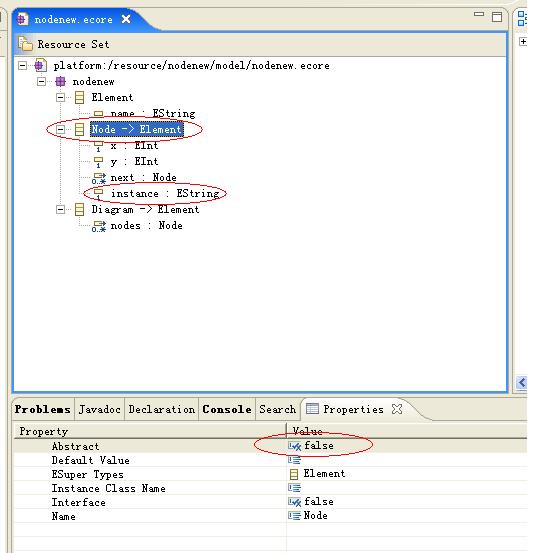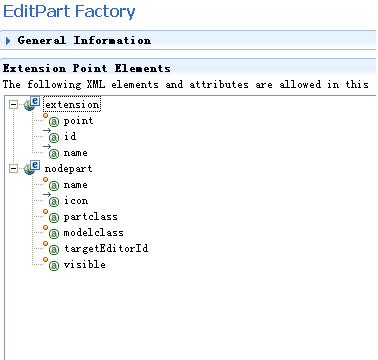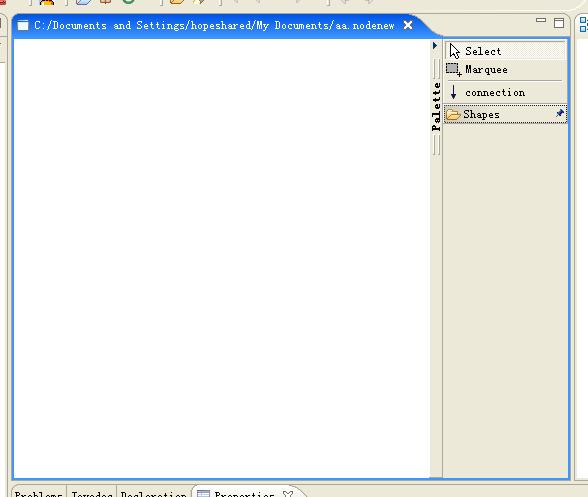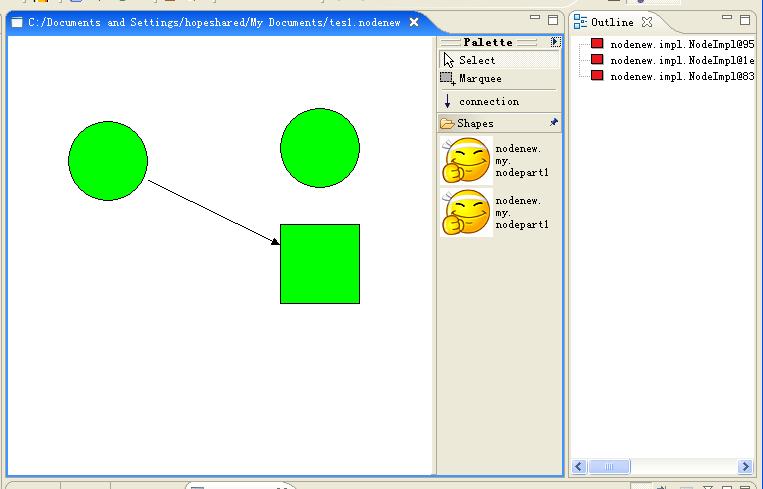作GEF編輯器的人,不知道有沒有發現這樣一個問題:每當作一個新的編輯器的時候,有很多代碼都和以前的類似。
我發現了這個問題,很多Command、Policy,包括EditPart都很類似,所以我經常采用Copy&Paste然后修改的方法來加快開發速度。
Eclipse采用的是插件擴展機制,做一次擴展就可以向Eclipse貢獻一個新的功能。同理,GEF編輯器中,畫板里的可編輯模型,是否也能這樣添加呢?
讓我們沿著這個思路走下去。
一 定義模型
初步的構想,仍然是繼續前兩篇文章的足跡,更改原來的例子。
模型的定義:
最開始做這個例子的時候,我將Node的Abstract設置為了true,因為我希望它就是一個抽象類,我將寫RectangleNode和EllipseNode繼承Node,他們才會出現在編輯器里。但是后來發現那樣做的話,文件確實可以編輯,但是文件保存之后,再次用EMF序列化為對象的時候會出錯。
什么?不信?那你自己試試。
這里,我給Node加了一個屬性instance,它表示這個對象的實現類。它將給我們代來一些麻煩。
二 創建模型工程
與前面的文章一樣,利用這個ecore文件創建一個EMF項目,并生成模型代碼。Ok,就把代碼放在這里,不再改動它了。這個工程的名稱是nodenew。
三 創建編輯器工程
如果說前面的工程僅創建了“抽象模型”,那么本工程就僅創建了基于前面模型的一個編輯器框架。
創建一個名為nodenew.gef的插件項目,其他的全部按默認設置。首先,這個插件依賴于nodenew。將nodetest中的command、editpart、connectionhelp、properties、ui包copy過來,將Connection.java和ModelManager.java也copy過來,修改代碼,盡可能的減少那些紅叉。
創建一個擴展點,我們將利用它來初始化編輯器畫板。
這個擴展點的用意很明確,就是貢獻模型并設置模型與EditPart的對應關系。
創建一個接口類,所有使用這個擴展點的EditPart需要實現這個接口:
MyEditPart.java

 public interface MyEditPart extends NodeEditPart
public interface MyEditPart extends NodeEditPart {
{ public void setConnection(Object model);
public void setConnection(Object model); public void removeConnection(Object model);
public void removeConnection(Object model); }
}
創建一個類,從擴展點中找到模型與EditPart的對應關系:
ModelToEditPartMap.java

 public class ModelToEditPartMap
public class ModelToEditPartMap  {
{
 private static Hashtable map = getTable();
private static Hashtable map = getTable();

 public static Hashtable getTable()
public static Hashtable getTable() {
{
 if(map==null)
if(map==null) {
{  map=new Hashtable();
map=new Hashtable(); IExtensionRegistry registry = Platform.getExtensionRegistry();
IExtensionRegistry registry = Platform.getExtensionRegistry(); IExtensionPoint point = registry.getExtensionPoint(MyConstants.FACTORY_EXTIONPOINT_ID);
IExtensionPoint point = registry.getExtensionPoint(MyConstants.FACTORY_EXTIONPOINT_ID);
 if (null == point)
if (null == point) {
{ System.err.println("No extension point called "+MyConstants.FACTORY_EXTIONPOINT_ID+" is found!");
System.err.println("No extension point called "+MyConstants.FACTORY_EXTIONPOINT_ID+" is found!"); return null;
return null; }
} IExtension[] extensions = point.getExtensions();
IExtension[] extensions = point.getExtensions();
 for (int i = 0; i < extensions.length; i++)
for (int i = 0; i < extensions.length; i++) {
{ IConfigurationElement[] elements = extensions[i].getConfigurationElements();
IConfigurationElement[] elements = extensions[i].getConfigurationElements();
 for (int j = 0; j < elements.length; j++)
for (int j = 0; j < elements.length; j++) {
{
 if (elements[j].getAttribute(MyConstants.ATTR_TARGETEDITORID).equals(MyConstants.EDITOR_ID))
if (elements[j].getAttribute(MyConstants.ATTR_TARGETEDITORID).equals(MyConstants.EDITOR_ID)) {
{ String eleType = elements[j].getName();
String eleType = elements[j].getName();
 if (eleType.equals(MyConstants.ELEMENT_NODEPART))
if (eleType.equals(MyConstants.ELEMENT_NODEPART)) {
{
 try
try {
{ map.put(elements[j].getAttribute(MyConstants.ATTR_MODELCLASS), elements[j]);
map.put(elements[j].getAttribute(MyConstants.ATTR_MODELCLASS), elements[j]); System.out.println("add a node " + elements[j].getAttribute(MyConstants.ATTR_NAME) + "to map");
System.out.println("add a node " + elements[j].getAttribute(MyConstants.ATTR_NAME) + "to map"); }
}
 catch(Exception e)
catch(Exception e) {
{ e.printStackTrace();
e.printStackTrace(); }
} }
} }
} }
} }
} }
} return map;
return map; }
}
 }
}
創建一個類,從擴展點中得到編輯器畫板里的元素。
FactoryExtension.java

 public class FactoryExtension
public class FactoryExtension  {
{  private static ArrayList factory = getFactory();
private static ArrayList factory = getFactory();

 public static ArrayList getFactory()
public static ArrayList getFactory()  {
{
 if(factory==null)
if(factory==null) {
{  factory=new ArrayList();
factory=new ArrayList(); IExtensionRegistry registry = Platform.getExtensionRegistry();
IExtensionRegistry registry = Platform.getExtensionRegistry(); IExtensionPoint point = registry.getExtensionPoint(MyConstants.FACTORY_EXTIONPOINT_ID);
IExtensionPoint point = registry.getExtensionPoint(MyConstants.FACTORY_EXTIONPOINT_ID);
 if (null == point)
if (null == point) {
{ System.err.println("No extension point called "+MyConstants.FACTORY_EXTIONPOINT_ID+" is found!");
System.err.println("No extension point called "+MyConstants.FACTORY_EXTIONPOINT_ID+" is found!"); return null;
return null; }
} IExtension[] extensions = point.getExtensions();
IExtension[] extensions = point.getExtensions();
 for (int i = 0; i < extensions.length; i++)
for (int i = 0; i < extensions.length; i++) {
{ IConfigurationElement[] elements = extensions[i].getConfigurationElements();
IConfigurationElement[] elements = extensions[i].getConfigurationElements(); String pluginId = extensions[i].getNamespace();
String pluginId = extensions[i].getNamespace(); Plugin a = null;
Plugin a = null;
 try
try  {
{ a = extensions[i].getDeclaringPluginDescriptor().getPlugin();
a = extensions[i].getDeclaringPluginDescriptor().getPlugin();
 } catch (InvalidRegistryObjectException e1)
} catch (InvalidRegistryObjectException e1)  {
{ // TODO Auto-generated catch block
// TODO Auto-generated catch block e1.printStackTrace();
e1.printStackTrace();
 } catch (CoreException e1)
} catch (CoreException e1)  {
{ // TODO Auto-generated catch block
// TODO Auto-generated catch block e1.printStackTrace();
e1.printStackTrace(); }
} a.getBundle();
a.getBundle();



 for (int j = 0; j < elements.length; j++)
for (int j = 0; j < elements.length; j++) {
{
 if (elements[j].getAttribute(MyConstants.ATTR_TARGETEDITORID).equals(MyConstants.EDITOR_ID))
if (elements[j].getAttribute(MyConstants.ATTR_TARGETEDITORID).equals(MyConstants.EDITOR_ID)) {
{ String eleType = elements[j].getName();
String eleType = elements[j].getName();
 if (eleType.equals(MyConstants.ELEMENT_NODEPART))
if (eleType.equals(MyConstants.ELEMENT_NODEPART)) {
{
 if(!Boolean.parseBoolean(elements[j].getAttribute(MyConstants.ATTR_VISIBLE)))
if(!Boolean.parseBoolean(elements[j].getAttribute(MyConstants.ATTR_VISIBLE))) {
{ continue;
continue; }
}
 try
try {
{ ImageDescriptor descriptor = null;
ImageDescriptor descriptor = null;
 try
try {
{ if(elements[j].getAttribute(MyConstants.ATTR_ICON)!=null)
if(elements[j].getAttribute(MyConstants.ATTR_ICON)!=null) descriptor = AbstractUIPlugin.imageDescriptorFromPlugin(pluginId, elements[j].getAttribute(MyConstants.ATTR_ICON));
descriptor = AbstractUIPlugin.imageDescriptorFromPlugin(pluginId, elements[j].getAttribute(MyConstants.ATTR_ICON));
 } catch(Exception e)
} catch(Exception e) {
{ e.printStackTrace();
e.printStackTrace(); }
}
 if(descriptor == null)
if(descriptor == null) {
{ descriptor = GefPlugin.getImageDescriptor(MyConstants.IMG_DEFAULT);
descriptor = GefPlugin.getImageDescriptor(MyConstants.IMG_DEFAULT); }
}
 ToolEntry tool = new CombinedTemplateCreationEntry(
ToolEntry tool = new CombinedTemplateCreationEntry( elements[j].getAttribute(MyConstants.ATTR_NAME),
elements[j].getAttribute(MyConstants.ATTR_NAME),  "Create a new Node",
"Create a new Node",  elements[j].getAttribute(MyConstants.ATTR_MODELCLASS),
elements[j].getAttribute(MyConstants.ATTR_MODELCLASS),  new MyCreationFactory(elements[j]), descriptor,descriptor);
new MyCreationFactory(elements[j]), descriptor,descriptor);
 factory.add(tool);
factory.add(tool); System.out.println("add a node " + elements[j].getAttribute(MyConstants.ATTR_NAME));
System.out.println("add a node " + elements[j].getAttribute(MyConstants.ATTR_NAME)); }
}
 catch(Exception e)
catch(Exception e) {
{ e.printStackTrace();
e.printStackTrace(); }
} }
} }
} }
} }
} }
} return factory;
return factory; }
}

 }
}
上面的類中使用的CreationFactory是自己重寫的一個類,它的目的在于,當用戶選中畫板中的一個對象的時候,發出了一個create的request,我們創建一個對象,封裝在這個request里,當編輯器截獲這個request的時候,就直接得到了新創建的這個模型對象。
MyCreationFactory.java

 public class MyCreationFactory implements CreationFactory
public class MyCreationFactory implements CreationFactory {
{
 private IConfigurationElement element;
private IConfigurationElement element;

 public MyCreationFactory(IConfigurationElement element)
public MyCreationFactory(IConfigurationElement element) {
{ this.element = element;
this.element = element; }
}

 public Object getNewObject()
public Object getNewObject()  {
{ 

 try
try  {
{ Object classname=null;
Object classname=null; 

 try
try  {
{ classname = WorkbenchPlugin.createExtension(element, MyConstants.ATTR_MODELCLASS);
classname = WorkbenchPlugin.createExtension(element, MyConstants.ATTR_MODELCLASS);
 } catch (CoreException e)
} catch (CoreException e)  {
{ // TODO Auto-generated catch block
// TODO Auto-generated catch block e.printStackTrace();
e.printStackTrace(); }
}
 if(classname instanceof Class)
if(classname instanceof Class) System.out.println("class");
System.out.println("class");
 return classname;
return classname; //
// 
 } catch (InvalidRegistryObjectException e)
} catch (InvalidRegistryObjectException e)  {
{ // TODO Auto-generated catch block
// TODO Auto-generated catch block e.printStackTrace();
e.printStackTrace(); }
}  return null;
return null; }
}
 public Object getObjectType()
public Object getObjectType()  {
{  return element.getAttribute(MyConstants.ATTR_MODELCLASS);
return element.getAttribute(MyConstants.ATTR_MODELCLASS);  }
}
 }
}
在這里碰到了一個關于ClassLoader的問題。假如不使用WorkbenchPlugin.createExtension(element, MyConstants.ATTR_MODELCLASS);
從當前的插件項目中load這個class會出現ClassNotFound異常。目前的這個解決方法不是很好,正在尋找更好的解決方案。
接著,修改NodeEditorPaletteFactory,從擴展點中初始化編輯器畫板:

 private static PaletteContainer createShapesDrawer()
private static PaletteContainer createShapesDrawer()  {
{ PaletteDrawer componentsDrawer = new PaletteDrawer("Shapes");
PaletteDrawer componentsDrawer = new PaletteDrawer("Shapes"); CombinedTemplateCreationEntry component=null;
CombinedTemplateCreationEntry component=null; ArrayList factory = FactoryExtension.getFactory();
ArrayList factory = FactoryExtension.getFactory();
 if(factory!=null && factory.size()>1)
if(factory!=null && factory.size()>1) {
{
 for(int i=0; i<factory.size(); i++)
for(int i=0; i<factory.size(); i++) {
{ component = (CombinedTemplateCreationEntry) factory.get(i);
component = (CombinedTemplateCreationEntry) factory.get(i); componentsDrawer.add(component);
componentsDrawer.add(component); }
} }
} return componentsDrawer;
return componentsDrawer; }
}
最后,修改NodesEditPartFactory,有些對象需要從擴展點中得到EditPart對象:

 private EditPart getPartForElement(Object modelElement)
private EditPart getPartForElement(Object modelElement)  {
{
 if (modelElement instanceof Diagram)
if (modelElement instanceof Diagram)  {
{ return new DiagramEditPart();
return new DiagramEditPart(); }
}
 if (modelElement instanceof Connection)
if (modelElement instanceof Connection)  {
{ return new ConnectionEditPart();
return new ConnectionEditPart(); }
}
 EditPart result = null;
EditPart result = null;
 if(modelElement instanceof Node)
if(modelElement instanceof Node) {
{
 String classname = ((Node)modelElement).getInstance();
String classname = ((Node)modelElement).getInstance(); IConfigurationElement element = (IConfigurationElement)ModelToEditPartMap.getTable().get(classname);
IConfigurationElement element = (IConfigurationElement)ModelToEditPartMap.getTable().get(classname);
 try
try  {
{  result = (EditPart) WorkbenchPlugin.createExtension(element, MyConstants.ATTR_PARTCLASS);
result = (EditPart) WorkbenchPlugin.createExtension(element, MyConstants.ATTR_PARTCLASS);
 } catch (CoreException e)
} catch (CoreException e)  {
{ // TODO Auto-generated catch block
// TODO Auto-generated catch block e.printStackTrace();
e.printStackTrace(); }
}
 }
}

 if(result==null)
if(result==null) {
{

 if(ModelToEditPartMap.getTable().containsKey(modelElement.getClass().getName()))
if(ModelToEditPartMap.getTable().containsKey(modelElement.getClass().getName())) {
{
 try
try  {
{ IConfigurationElement element = (IConfigurationElement)ModelToEditPartMap.getTable().get(modelElement.getClass().getName());
IConfigurationElement element = (IConfigurationElement)ModelToEditPartMap.getTable().get(modelElement.getClass().getName());
 result = (EditPart) WorkbenchPlugin.createExtension(element, MyConstants.ATTR_PARTCLASS);
result = (EditPart) WorkbenchPlugin.createExtension(element, MyConstants.ATTR_PARTCLASS);

 }catch (CoreException e)
}catch (CoreException e)  {
{ // TODO Auto-generated catch block
// TODO Auto-generated catch block e.printStackTrace();
e.printStackTrace(); }
} }
} }
}

 if(result!=null && result instanceof MyEditPart)
if(result!=null && result instanceof MyEditPart) {
{ ((MyEditPart)result).removeConnection(modelElement);
((MyEditPart)result).removeConnection(modelElement); ((MyEditPart)result).setConnection(modelElement);
((MyEditPart)result).setConnection(modelElement);  return result;
return result; }
}
 throw new RuntimeException(
throw new RuntimeException( "Can't create part for model element: "
"Can't create part for model element: " + ((modelElement != null) ? modelElement.getClass().getName() : "null"));
+ ((modelElement != null) ? modelElement.getClass().getName() : "null")); }
}
這個時候,編輯器的框架已經搭建好了,運行一下看看吧。
可以看到,畫板里的Connection是一直都有的,但是卻沒有Node對象。
四 創建自己的擴展
再建一個新的插件項目,名為nodenew.my,它依賴于前面的2個插件。
首先創建模型對象:
EllipseNode.java

 public class EllipseNode extends NodeImpl
public class EllipseNode extends NodeImpl {
{
 public EllipseNode()
public EllipseNode() {
{ super();
super(); this.instance = this.getClass().getName();
this.instance = this.getClass().getName(); }
} }
}
RectangleNode.java

 public class RectangleNode extends NodeImpl
public class RectangleNode extends NodeImpl {
{
 public RectangleNode()
public RectangleNode() {
{ super();
super(); this.instance = this.getClass().getName();
this.instance = this.getClass().getName(); }
} }
}
接著創建EditPart:
EllipseNodeEditPart.java

 public class EllipseNodeEditPart extends NodesEditPart implements MyEditPart
public class EllipseNodeEditPart extends NodesEditPart implements MyEditPart {
{
 protected IFigure createFigure()
protected IFigure createFigure()  {
{ IFigure f = new Ellipse();
IFigure f = new Ellipse();
 f.setOpaque(true); // non-transparent figure
f.setOpaque(true); // non-transparent figure f.setBackgroundColor(ColorConstants.green);
f.setBackgroundColor(ColorConstants.green); return f;
return f; }
}

 public void removeConnection(Object model)
public void removeConnection(Object model) {
{
 if(TargetAddConnectionTable.getInstance().contains((Node) model))
if(TargetAddConnectionTable.getInstance().contains((Node) model)) {
{ List l = TargetAddConnectionTable.getInstance().getValue( (Node)model);
List l = TargetAddConnectionTable.getInstance().getValue( (Node)model);
 if(l!=null && l.size()>0)
if(l!=null && l.size()>0) {
{
 for(int i=0; i<l.size(); i++)
for(int i=0; i<l.size(); i++) {
{ Connection c = (Connection) l.get(i);
Connection c = (Connection) l.get(i); this.getModelSourceConnections().add(c);
this.getModelSourceConnections().add(c); TargetAddConnectionTable.getInstance().remove(c);
TargetAddConnectionTable.getInstance().remove(c); }
} }
} }
} }
} 

 public void setConnection(Object model)
public void setConnection(Object model) {
{
 if(((Node)model).getNext()!=null && ((Node)model).getNext().size()>0)
if(((Node)model).getNext()!=null && ((Node)model).getNext().size()>0) {
{
 for(int i=0; i<((Node)model).getNext().size(); i++)
for(int i=0; i<((Node)model).getNext().size(); i++) {
{ Connection c = new Connection();
Connection c = new Connection(); c.setSource((Node) model);
c.setSource((Node) model); c.setTarget((Node) ((Node)model).getNext().get(i));
c.setTarget((Node) ((Node)model).getNext().get(i)); this.getModelTargetConnections().add(c);
this.getModelTargetConnections().add(c); TargetAddConnectionTable.getInstance().add(c, (Node) c.getTarget());
TargetAddConnectionTable.getInstance().add(c, (Node) c.getTarget()); }
} }
} }
}
 }
}
RectangleNodeEditPart.java

 public class RectangleNodeEditPart extends NodesEditPart implements MyEditPart
public class RectangleNodeEditPart extends NodesEditPart implements MyEditPart {
{
 protected IFigure createFigure()
protected IFigure createFigure()  {
{ IFigure f = new RectangleFigure();
IFigure f = new RectangleFigure(); f.setOpaque(true); // non-transparent figure
f.setOpaque(true); // non-transparent figure f.setBackgroundColor(ColorConstants.green);
f.setBackgroundColor(ColorConstants.green); return f;
return f; }
}

 public void removeConnection(Object model)
public void removeConnection(Object model) {
{
 if(TargetAddConnectionTable.getInstance().contains((Node) model))
if(TargetAddConnectionTable.getInstance().contains((Node) model)) {
{ List l = TargetAddConnectionTable.getInstance().getValue( (Node)model);
List l = TargetAddConnectionTable.getInstance().getValue( (Node)model);
 if(l!=null && l.size()>0)
if(l!=null && l.size()>0) {
{
 for(int i=0; i<l.size(); i++)
for(int i=0; i<l.size(); i++) {
{ Connection c = (Connection) l.get(i);
Connection c = (Connection) l.get(i); this.getModelSourceConnections().add(c);
this.getModelSourceConnections().add(c); TargetAddConnectionTable.getInstance().remove(c);
TargetAddConnectionTable.getInstance().remove(c); }
} }
} }
} }
} 


 public void setConnection(Object model)
public void setConnection(Object model) {
{
 if(((Node)model).getNext()!=null && ((Node)model).getNext().size()>0)
if(((Node)model).getNext()!=null && ((Node)model).getNext().size()>0) {
{
 for(int i=0; i<((Node)model).getNext().size(); i++)
for(int i=0; i<((Node)model).getNext().size(); i++) {
{ Connection c = new Connection();
Connection c = new Connection(); c.setSource((Node) model);
c.setSource((Node) model); c.setTarget((Node) ((Node)model).getNext().get(i));
c.setTarget((Node) ((Node)model).getNext().get(i)); this.getModelTargetConnections().add(c);
this.getModelTargetConnections().add(c); TargetAddConnectionTable.getInstance().add(c, (Node) c.getTarget());
TargetAddConnectionTable.getInstance().add(c, (Node) c.getTarget()); }
} }
} }
}
 }
}
聲明本次擴展:
plugin.xml
 <extension
<extension point="nodenew.gef.editpartfactory">
point="nodenew.gef.editpartfactory"> <nodepart
<nodepart modelclass="nodenew.model.EllipseNode"
modelclass="nodenew.model.EllipseNode" name="nodenew.my.nodepart1"
name="nodenew.my.nodepart1" partclass="nodenew.editpart.EllipseNodeEditPart"
partclass="nodenew.editpart.EllipseNodeEditPart" targetEditorId="nodenew.ui.NodesEditor"
targetEditorId="nodenew.ui.NodesEditor" visible="true"/>
visible="true"/> <nodepart
<nodepart modelclass="nodenew.model.RectangleNode"
modelclass="nodenew.model.RectangleNode" name="nodenew.my.nodepart1"
name="nodenew.my.nodepart1" partclass="nodenew.editpart.RectangleNodeEditPart"
partclass="nodenew.editpart.RectangleNodeEditPart" targetEditorId="nodenew.ui.NodesEditor"
targetEditorId="nodenew.ui.NodesEditor" visible="true"/>
visible="true"/> </extension>
</extension>
看看結果吧
五 其他
本例仍然利用兩個action來打開編輯器。
不知道這次的研究成果是不是可以發表成學術論文呢??我覺得挺有創意的,呵呵。![]()
六 源碼
七 運行環境
JDK 1.4
Eclipse 3.1
EMF
GEF








